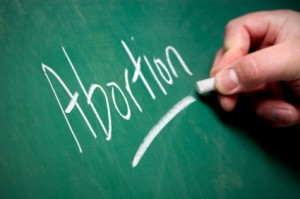La tasa de aborto en los Estados Unidos cayó a su punto más bajo desde que la Corte Suprema legalizó el procedimiento en todos los 50 estados, según un estudio que sugiere que la nueva, de acción prolongada métodos anticonceptivos están teniendo un impacto significativo en la reducción de los embarazos no deseados.
Había menos de 17 abortos por cada 1,000 mujeres en 2011, the latest year for which figures were available, according a paper published Monday from the Guttmacher Institute, a pro-abortion-rights think tank. That is down 13 ciento de 2008 and a little higher than the rate in 1973, when the Supreme Court handed down its landmark Roe v. Vadear decisión.
The study did not examine the reasons for the drop. But the authors suggested that one factor was greater reliance on new kinds of birth control, including intra-uterine devices such as Mirena, which can last for years and are not susceptible to user error like daily pills or condoms.
They also noted the economy as a contributing factor, because people tend to adhere more strictly to their birth control during tough economic times. But they did not credit the recent wave of state laws restricting access to abortion, because most of those took effect in 2011 or later.
Those restrictions will surely have an impact on the numbers going forward, said Rachel K. Jones, a senior researcher at Guttmacher and lead researcher on the paper.
“If the abortion rate continues to drop, we can’t assume it’s all due to positive factors” such as better adherence to contraceptives, dijo, calling the laws passed in 22 states “onerous.”
The report comes as tensions intensify in the long-simmering debate over abortion and contraception. Religious groups are locked in a closely watched battle with the Obama administration over new rules that require employers to offer birth control free of charge as part of their health insurance benefit packages. The Supreme Court will decide this year whether employers with religious objections may opt out of those rules.
State legislatures are preparing to push through another raft of restrictive laws, after a record-setting period that saw the enactment dozens of new regulations that critics say will impede women’s access to abortion.
The new laws include requirements that women undergo ultrasounds before obtaining abortions, as well as licensing and inspection requirements for abortion providers.
Nine states banned the procedure after 20 weeks of pregnancy, part of a national effort by abortion opponents to force the Supreme Court to revisit the legality of abortion.
The political clashes, now and over the years, have overshadowed a trend cheered, albeit cautiously, by both sides of the issue: The number of abortions in the United States has been decreasing.
“We are extremely happy that the abortion numbers are going down and continue to be declining over the years,” said Carol Tobias, president of National Right to Life, a prominent antiabortion group.
Such groups, including Tobias’s, rechazar la conclusión del Instituto Guttmacher que la disminución no está relacionada con las regulaciones estatales que restringen el acceso al procedimiento, porque mientras que el principal aumento en las nuevas leyes se produjo en 2011, algunas leyes vinieron antes. Por ejemplo, 39 estados requieren notificación a los padres o el consentimiento de un menor de edad para obtener un aborto.
Dicen que la conversación gráfico en la década de 1990 en todo el procedimiento que ellos llaman "tardío" el aborto contribuyó a una mayor conciencia de, y el horror sobre, cómo se realizan abortos. Y se acreditan las nuevas tecnologías que permiten a las personas para observar mejor lo que ocurre en el útero, incluso en las primeras etapas del embarazo.
"Esta es una generación post-sonograma,"Dijo Charmaine Yoest, presidente de Americans United for Life, el grupo detrás de muchos de los nuevos límites estatales sobre abortos. “There is increased awareness throughout our culture of the moral weight of the unborn baby. And that’s a good thing.”
Guttmacher researchers said it is unlikely that previous laws had an impact, because they examined the abortion rate in more liberal states that did not enact such laws prior to 2011 and found no difference in the trend.
The study released Monday shows that, after a plateau from 2005 a 2008, the long-term decline in the abortion rate has resumed. The rate has dropped significantly from its all-time high in 1981, when there were roughly 30 abortos por cada 1,000 women of reproductive age. The overall number of abortions also fell 13 ciento de 2008 to nearly 1.1 millones en 2011, the study said.
The results echo a report last year from the Centers for Disease Control and Prevention, which also found a decline in the abortion rate after a plateau. That report, which used a different methodology, pegged the abortion rate in 2010 as 14.6 abortions per 1,000 women of reproductive age.
The numbers of abortions are not easily sussed out, because providers are not required to report them. The CDC draws from state health department reports, and its data are incomplete. Por ejemplo, California — responsible for an estimated 17 percent of abortions nationwide — does not gather data on the number of abortions.
Guttmacher approaches the task differently, conducting a periodic census by mailing a questionnaire to all known abortion providers. They follow up over the phone with those who do not respond and use health-department and other data to fill any remaining gaps. The report is set to be published in the March issue of the peer-reviewed journal Perspectives on Sexual and Reproductive Health.
Los expertos advirtieron que las cifras documentadas por Guttmacher en el período inmediatamente posterior a Roe v. Vadear puede ser particularmente inestable. Muchos abortos todavía tenían lugar bajo tierra y fuera de los libros en ese momento.
El informe del lunes mostró que un cambio en el método preferido de las mujeres del aborto. Los investigadores encontraron que casi uno de cada cuatro de todos los abortos no hospitalarios fueron el resultado de la píldora del aborto, desde 17 por ciento en 2008. El número total de proveedores de aborto disminuyó 4 por ciento respecto al mismo período.
Seis estados experimentaron ningún cambio o un aumento en sus tasas de aborto: Alaska, Maryland, Montana, New Hampshire, Virginia Occidental y Wyoming. Los investigadores no explican por qué esos estados desafiaron la tendencia general.
Fuente: Washington Post



Sin comentarios
Comentarios para Estudio: Tasa de aborto en el punto más bajo desde 1973 están cerradas.